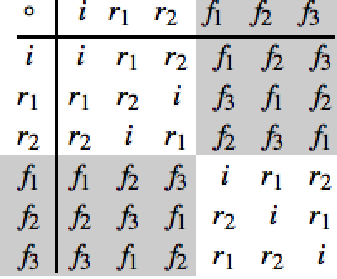We have seen that \(A_3= \left\{i,r_1,r_2\right\}\) is a subgroup of \(S_3\text{,}\) and its left cosets are \(A_3\) itself and \(B_3=\left\{f_1,f_2,f_3\right\}\text{.}\) Whether \(\left\{A_3 , B_3 \right\}\) is a group boils down to determining whether the induced operation is well defined. Consider the operation table for \(S_3\) in Figure 15.4.2.

Operation table for \(S_3\)
We have shaded in all occurrences of the elements of \(B_3\) in gray. We will call these elements the gray elements and the elements of \(A_3\) the white ones.
Now consider the process of computing the coset product \(A_3\circ B_3\text{.}\) The “product” is obtained by selecting one white element and one gray element. Note that white “times” gray is always gray. Thus, \(A_3\circ B_3\) is well defined. Similarly, the other three possible products are well defined. The table for the factor group \(S_3/A_3\) is
\begin{equation*}
\begin{array}{c|c}
\circ &
\begin{array}{cc}
A_3 & B_3 \\
\end{array}
\\
\hline
\begin{array}{c}
A_{3 } \\
B_3 \\
\end{array}
&
\begin{array}{cc}
A_3 & B_3 \\
B_3 & A_3 \\
\end{array}
\\
\end{array}
\end{equation*}
Clearly, \(S_3/A_3\) is isomorphic to \(\mathbb{Z}_2\text{.}\) Notice that \(A_3\) and \(B_3\) are also the right cosets of \(A_3\text{.}\) This is significant.

